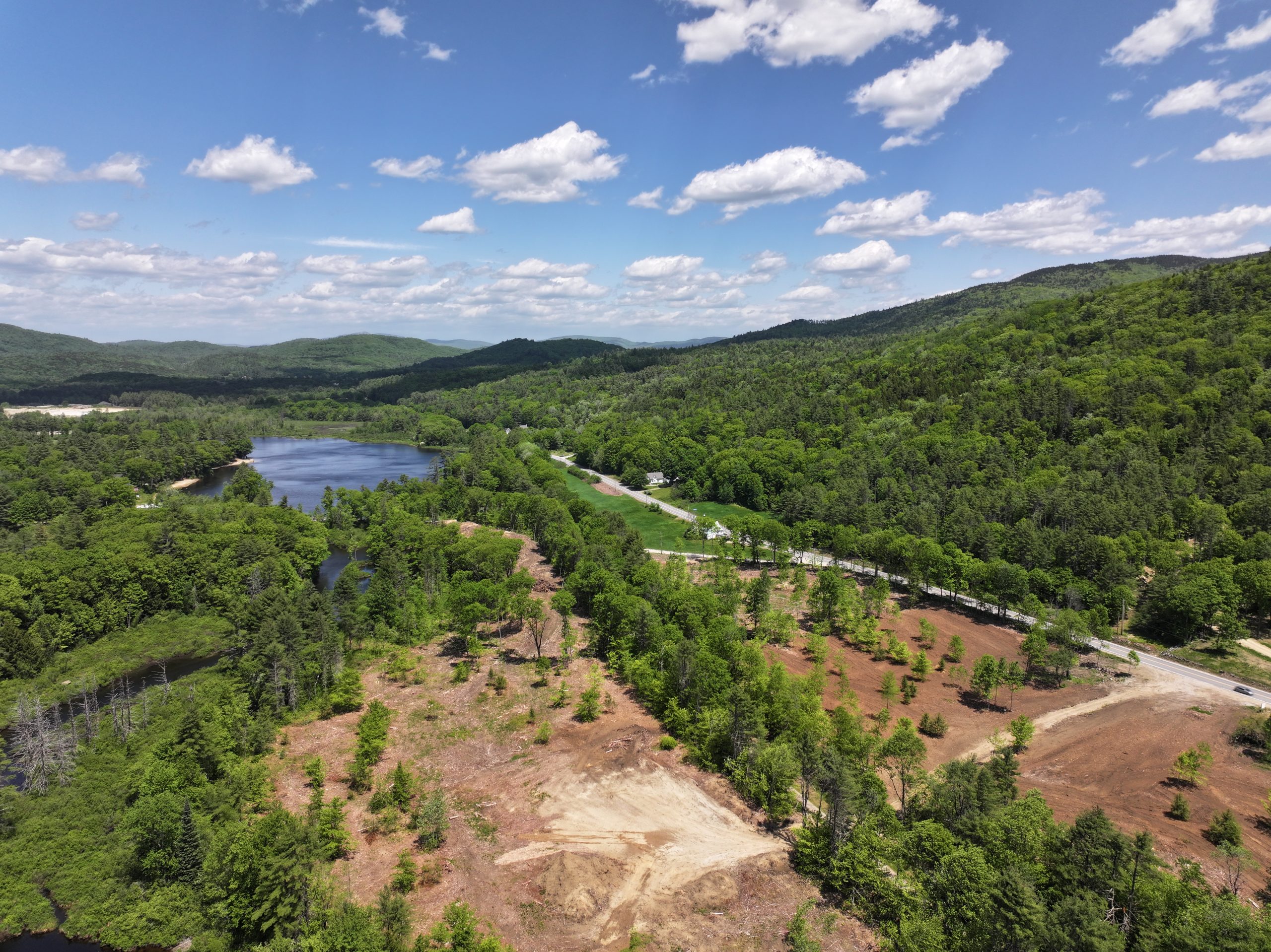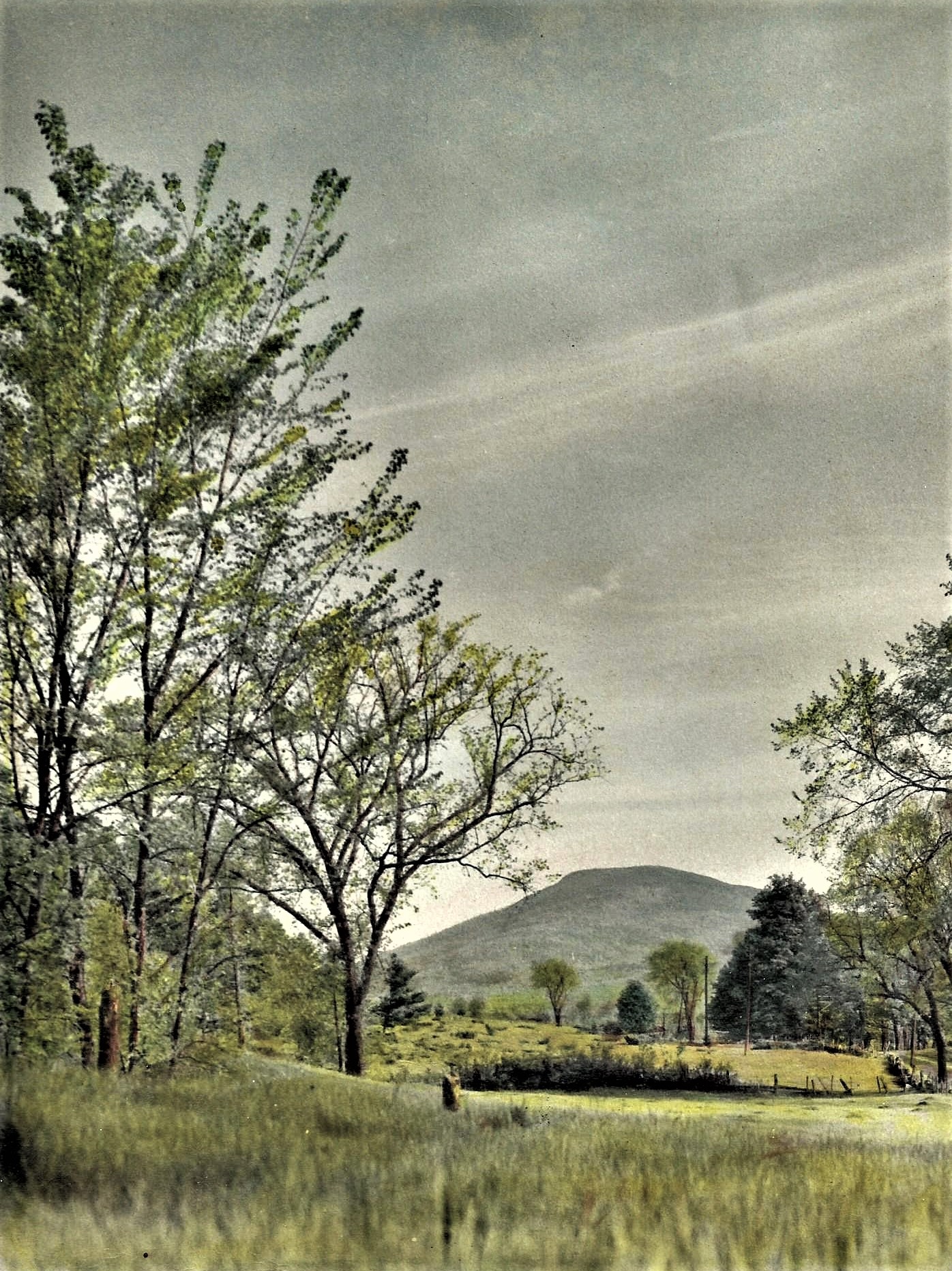
of this photograph. Photo: Pellettieri Associates.
“Mountain’s real pretty today,” poet Donald Hall’s grandmother, Kate Wells, would say every morning, looking out the kitchen window. Or, “Can’t see the mountain too good today.” Her reports spoke not only of the surround of place that has informed life for generations at Eagle Pond Farm but also of the importance of Kearsarge in orienting each day lived there.
Note for Shelley – Insert [photograph, c. 1930] – Beth/Jan: delete this sentence when posting
This was the view that Kate saw from the kitchen window and Wesley, Don’s grandfather, saw from the barn and dooryard in those years when a neighbor’s pasture was still open. It’s what Jane Kenyon and Donald Hall, when they arrived in 1975, saw from the porch and yard, from the same kitchen window, the sitting room, and the upstairs rooms where they wrote.
By then, however, a stand of red pine the neighbor had planted in the old pasture in the 1950s was beginning to intrude on the view. And before long, though its presence was strongly felt, the mountain became less and less visible, except directly over Route 4, which edges the yard.

Last year, two partners of a logging company bought what was once that Andover pasture (located on the town line with Wilmot and abutting Eagle Pond Farm). Then, this winter, they took out the red pine because it was infected with red pine scale. The timber cut reopened the old, fond view of Kearsarge — so it looks, again, almost exactly as it did in the 1930 photograph.
The land clearing also removed, however, the trees that could have shielded Eagle Pond Farm, a national historic landmark, from development recently approved on the Andover property.
What’s at risk?
From the time a farm was established at Eagle Pond in the early 1800s, farmland and forest, near hills and mountains, have defined its setting and bestowed a deep sense of place. A railroad line from Boston, providing eventual service to Montreal and Quebec, was laid across the farm in 1847 and became a fact of daily life.
The simple dirt road in front of the house became an increasingly traveled highway. And over time, new houses were interspersed among old ones elsewhere. But the landscape here held its own. Old memory prevailed, until now.
If houses are built on the six lots facing onto Route 4, the impact on the physical setting of Eagle Pond Farm will be severe. Anything introduced there will be fully visible from what Don called the “house of poetry” and along the approach to the farm, because so few trees are left to filter the view. Impact on the way that Don’s and Jane’s years at the farm are understood and the inspiration for their work is conveyed will be as consequential.
The farm will not look like or feel like the place they knew. And if the historic vista is lost, once gone it can’t be reconstructed.
Can the farm’s sense of place be protected?
Since the loggers presented a subdivision plan to Andover, after the land clearing, a broad group of neighbors, townspeople, and others with concern for conservation — and preservation of the viewshed and setting of Eagle Pond Farm — have, along with At Eagle Pond, Inc. and in partnership with the Ausbon Sargent Land Preservation Trust, been working toward a conservation purchase of as much as possible of the property that’s for sale.
If this can be accomplished, the deed and the responsibilities of oversight will be held by the land trust (ausbonsargent.org), which has a strong history of preserving, protecting, and encouraging care of the rural character of the Kearsarge, Ragged, and Lake Sunapee region of New Hampshire.
This property adjoins an area of more than 4,000 acres in Wilmot, Danbury, and Andover already established as conservation land, including all of Eagle Pond Farm — 150 acres extending from the pond to the mid-reaches of Ragged — which Don and Jane protected by conservation easements in 1987 and 1992. It would not be an isolated parcel but integral to the whole.
The property is also next to Eagle Pond, adjacent to the Northern Rail Trail, and very close to the Sunapee-Ragged-Kearsarge Greenway. It includes, too, a critical wildlife habitat, a river that would be at risk from runoff, and a corridor long used by deer and black bear between Ragged and land to the west.
The sellers are sympathetic to the concerns around conservation and preservation of Eagle Pond Farm and are working with the nonprofit to find a way forward. Because, however, they have an investment to recover, money figures largely in a resolution and time is limited.
On the backside of the property, a 14-acre parcel along what becomes the Blackwater River is — through the action of an Andover citizen and the cooperation of the sellers — on its way to protection as conservation land. But the lots of most concern to Eagle Pond Farm, on not quite 12 acres fronting on Route 4 and Eagle Pond Road, remain vulnerable.
To size up the moment:
because of major financial need of its own to meet basic operating expenses and to undertake work on the house and barn, the nonprofit that is steward of Eagle Pond Farm is in no position to buy any of this property abutting the farm. What happens there is, however, of great consequence to what the organization has taken on.
A shared public effort — through the land trust — for conservation purchase of the land can turn this moment into an opportunity to ensure, for everyone who passes by, the future of this wayside area, the historic farm setting, and all that it contributes to understanding and remembrance of the work of our very celebrated, and also very local, poets — Donald Hall and Jane Kenyon — who put this place at the heart of their poetry, along with the habits and seasons and people of this place.
To make or discuss a pledge toward conservation purchase of this property, or to ask for additional information, please contact Andy Deegan, Interim Executive Director of the Ausbon Sargent Land Preservation Trust (email: adeegan@nullausbonsargent.org; telephone: 603 526-6555). For questions specific to Eagle Pond Farm or At Eagle Pond, Inc., please send an email (at.eagle.pond@nullgmail.com) and provide a phone number if you would prefer a call, rather than email, in return.
Pledges can be for outright donations toward purchase or for helping to secure a purchase contract with monies lent for that purpose. Outright donations are fully tax-deductible but are not reimbursable. Pledges of loans to help enable purchase until fundraising can recover such monies that are lent are not tax-deductible but are reimbursable within certain limitations.